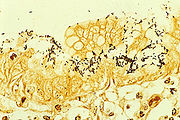
Warthin–Starry stain
Encyclopedia

Silver nitrate
Silver nitrate is an inorganic compound with chemical formula . This compound is a versatile precursor to many other silver compounds, such as those used in photography. It is far less sensitive to light than the halides...
-based staining method (a silver stain
Silver stain
Silver staining is the use of silver to selectively alter the appearance of the target.-Use in medicine:It is used to stain histologic sections. This kind of staining is important especially to show proteins and DNA. It is used to show both substances inside and outside cells...
) used in histology. It was first introduced in 1920 by American pathologists Aldred S. Warthin and Allen C. Starry, for the detection of spirochete
Spirochaete
Spirochaetes belong to a phylum of distinctive Gram-negative bacteria, which have long, helically coiled cells...
s. It has been considered the best stain for detection of spirochetes, and is also used to stain Helicobacter pylori
Helicobacter pylori
Helicobacter pylori , previously named Campylobacter pyloridis, is a Gram-negative, microaerophilic bacterium found in the stomach. It was identified in 1982 by Barry Marshall and Robin Warren, who found that it was present in patients with chronic gastritis and gastric ulcers, conditions that were...
, Lawsonia intracellularis, Microsporidia
Microsporidia
The microsporidia constitute a phylum of spore-forming unicellular parasites. They were once thought to be protists but are now known to be fungi. Loosely 1500 of the probably more than one million species are named now. Microsporidia are restricted to animal hosts, and all major groups of animals...
, and particulates.
WS stains organisms dark brown to black, and the background light golden brown/golden yellow.

